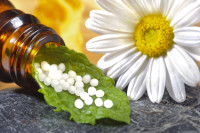What is homeopathy?
 Homeopathy is a scientific healing modality based on the law of similiars (“like cures like”). During the homeopathic intake, the practitioner will want to find out as much information as possible about your unique symptoms as a whole person (mental, emotional, and physical). Once all the symptoms have been gathered, the practitioner will select the homeopathic remedy which most closely matches your exact symptoms. When a perfect match is made, the remedy rapidly stimulates your body’s own healing ability in a gentle way, thereby removing symptoms of the disease. Homeopathic remedies are selected in a highly individualized way. For example, 10 people with rheumatoid arthritis may each need a different homeopathic remedy, based on their individual manifestation of the illness.
Homeopathy is a scientific healing modality based on the law of similiars (“like cures like”). During the homeopathic intake, the practitioner will want to find out as much information as possible about your unique symptoms as a whole person (mental, emotional, and physical). Once all the symptoms have been gathered, the practitioner will select the homeopathic remedy which most closely matches your exact symptoms. When a perfect match is made, the remedy rapidly stimulates your body’s own healing ability in a gentle way, thereby removing symptoms of the disease. Homeopathic remedies are selected in a highly individualized way. For example, 10 people with rheumatoid arthritis may each need a different homeopathic remedy, based on their individual manifestation of the illness.
What is a homeopathic medicine (remedy)?
Homeopathic remedies are natural medicines made from plants, minerals, and some animal substances, but by far the largest number are made from plants. Currently, there are over 3000 homeopathic remedies available for use. Homeopathic medicines are prepared by strict FDA guidelines, in a very unique way so that the final product is highly dilute and therefore, very safe and non-toxic. Small sugar pellets are moistened with the medicine, then bottled. The most common way to take a homeopathic remedy is to place a few of these pellets under the tongue and allow them to dissolve. Most people, even small children, find that they taste good and are very easy to take.
What is the difference between naturopathic medicine and homeopathy?
Naturopathic medicine is a holistic approach to healthcare, a blend of art and science that combines modern research with ancient healing modalities. Naturopathic medicine is based on 6 sound philosophical principles, the first one being “Vis medicatrix naturae” or The Healing Power of Nature. Homeopathy is one of the healing modalities employed in naturopathic medicine. I was trained at a four year accredited, naturopathic medical school. During this training I received a thorough education in all the basic sciences, diagnostics, and pharmacology (very similar to conventional medical school). However, our training departs from conventional medical school in that we receive substantial training in nutrition, botanical medicine, physical medicine, environmental medicine, hydrotherapy, acupuncture, and homeopathy. I chose to focus my practice on homeopathy because throughout my training, I found it to be the most profound healing tool at our disposal.
What is an example of a homeopathic medicine?
A good example is the homeopathic medicine Sepia officinalis. Sepia is made from the ink of the cuttlefish. This ink is fairly toxic and produces symptoms that are common to a depressive episode. Below is a list of symptoms that Sepia produces.
Depressed mood, with apathy, indolence, and irritability.
Marked indifference to things loved the most: especially family, occupation, etc.
Irritability and indifference towards loved ones.
Sadness, with desire to be alone, consolation makes them feel worse, hates pity.
Depressed with fatigue in the morning, evening, and from 2-4 pm.
Sadness when walking in the open air.
Mood always better when occupied or busy.
Mood very much improved by exercise
Stomach feels empty, nausea, better eating.
Chilly, and better from heat
If you have the EXACT same symptoms that this ink produces and you take a homeopathic preparation of Sepia, you will get better.
Is homeopathy safe?
Yes, homeopathy is the safest form of medicine we know of. The remedies are extremely dilute, so they will not interact with medications, herbs, and vitamins. They are also free from harmful side effects. Homeopathy is even safe to use in pregnant or nursing women and infants.
How quickly can I expect to feel better?
After taking the correct remedy, most people notice an improvement in overall well-being within a day. Symptoms then continue to improve each day, until the remedy wears off, at which point improvement will stop. Then a new remedy will need to be selected to continue the positive reaction. This process continues until all symptoms have resolved, and the person is in perfect health. The length of this process varies from person to person. Achieving lasting wellness takes time. Feeling better happens much more quickly.
